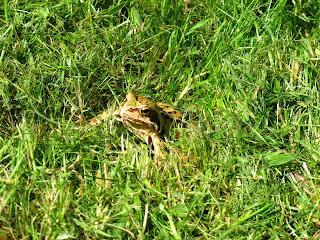This past weekend, I had the great pleasure of being a guest at Ashe Park, just outside of Steventon in Hampshire. My friend, Laura, from the BB2B walk, has been inviting me to visit since November, and I've been rather slow about getting around to it, but I am so glad I finally did. I enjoyed visiting with Laura and her family and the house and grounds are amazing. I was able to accompany them on several walks. Two around the grounds of Ashe Park, which included visits to the pond, a copse, and some sheep. They've been letting the grass grow a bit longer--much to the chagrin of the gardeners who think it looks untidy--to encourage insect life. I think it's working. We saw many butterflies, including some common blue, bees, flies, grasshoppers, and moths. They also have a ton of mini frogs, soon to grow to be toads. The toads make their way to the pond at the right time of year to lay eggs. Then come summer, these adorable, finger-nail sized, little frogs leave the pond and spread across the grounds in all directions. There are so many and they are so small that one has to be careful where one steps. Laura said the gardener hates mowing the lawn this time of year.
Laura, who just finished a biking trip in France, is gearing up for another big walk: 3 1/2 days around the Isle of Wight. They do training walks a few days a week. Sundays are the big walks. We went out for two hours, starting from Ashe Park, to White Hill. Park of the walk went along the Wayfarers Walk. We were accompanied by 3 dogs, a westie, a lab, and a great dane, who added a bit of entertainment to the walk. Some sites seem to say that the book Watership Down was based on this area. It was really beautiful. There were several parts that felt like you were really out in the country. No roads, no buildings in sight. We passed through fields of linseed, barley, and oats. Some golden fields, some recently cut, some green. It was good weather--overcast, but warm--and stunning scenery. On one track, one of the other walkers informed us that we were on the old main road to Winchester, which was at one point the capitol of England.
Steventon was the home of Jane Austen. She visited Ashe Park in her time--which she probably wouldn't recognize now--and wrote letters to her sister from there. Laura also took me to Winchester--a beautiful town with a ton of old, timber frame buildings and site of the oldest bar in England--where Jane Austen is buried.
Really great, relaxing weekend with excellent company and long walks. Thanks, Laura!






































